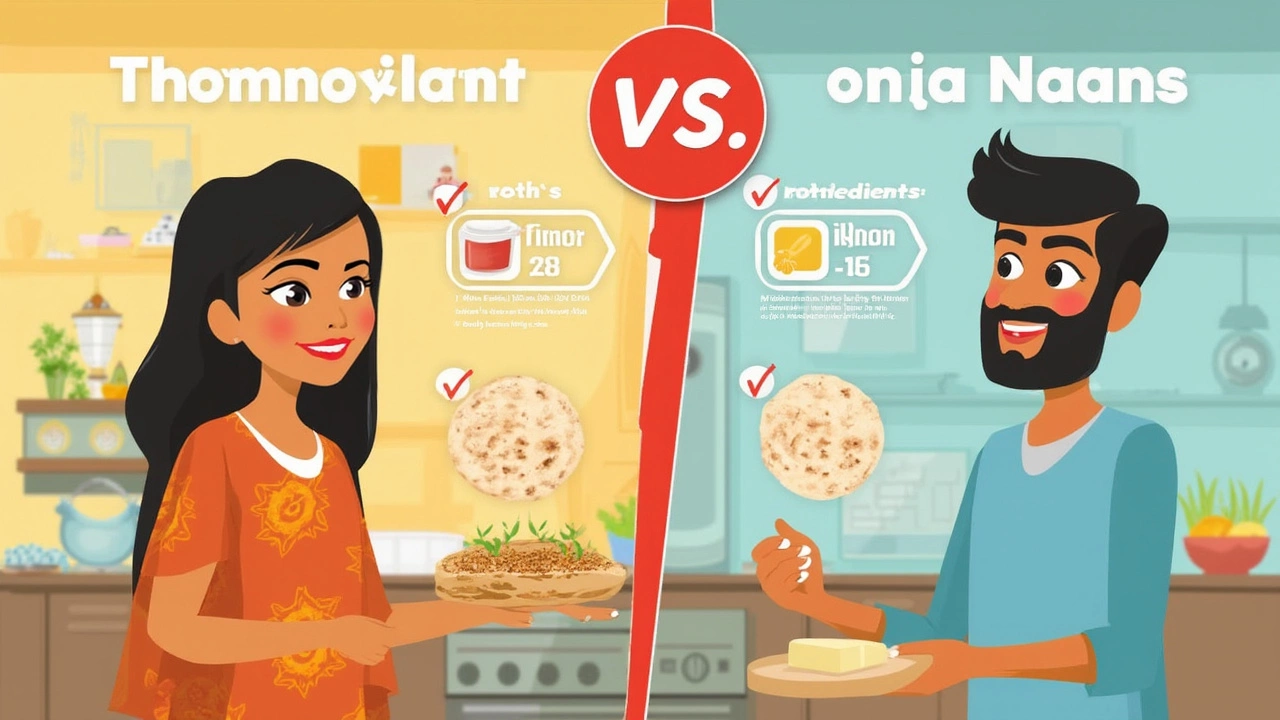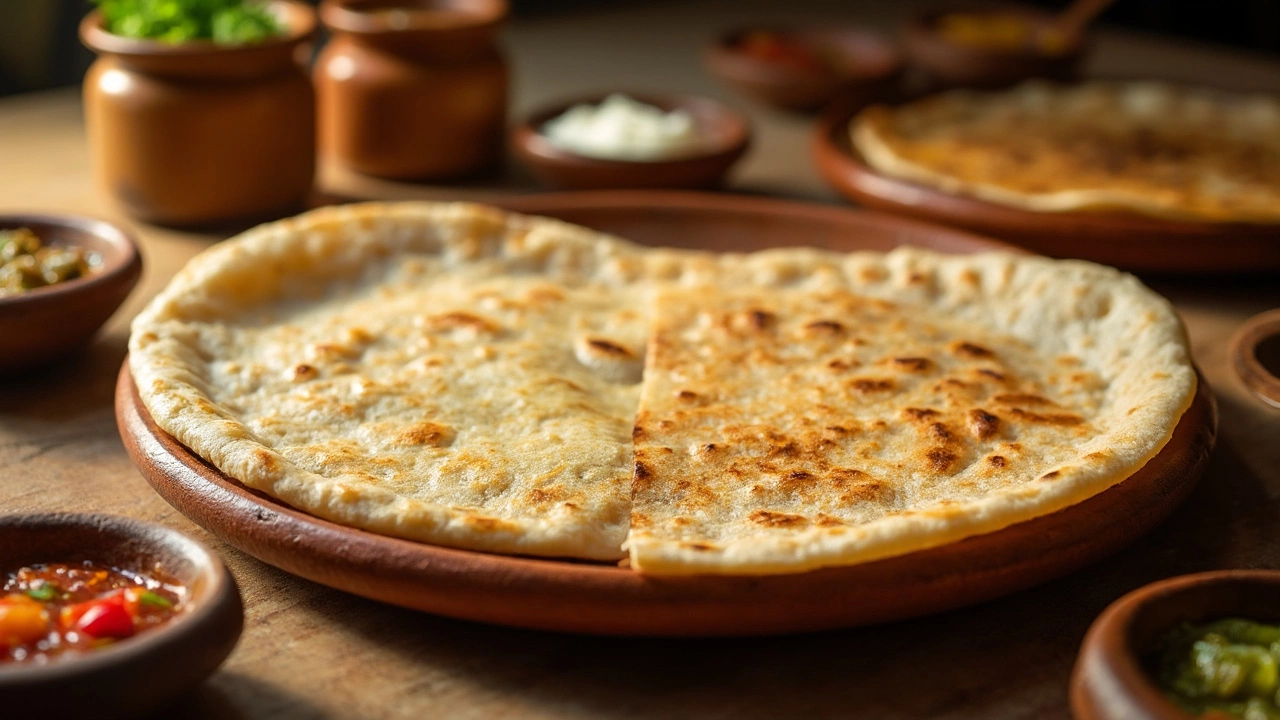Ever sat at an Indian restaurant, stared at the menu, and wondered if you should pick roti or naan with your curry? You’re not alone. Most people aren’t sure which Indian bread is actually better if you’re watching what you eat. The truth is, one is a lot lighter and simpler than the other, but both have their pros and cons depending on your goals.
Let’s get one thing straight: both roti and naan are delicious, and they both get the job done when it comes to scooping up dal or wiping up curry sauce. But they’re not twins. Roti is usually made with just whole wheat flour and water—sometimes a pinch of salt or a drop of oil. Naan? Well, that’s the bread with all the extras—refined white flour, yogurt, sometimes milk, butter, or even ghee.
If you're thinking about calories, fiber, and how long you’ll stay full after eating, these differences actually matter. The type of flour, the extra ingredients, and even how these breads are cooked all have a say in whether your meal ends up feeling heavy or light.
So, if you’re looking for the facts to help you build a healthier plate, or just trying to nail down the best bread to keep your jeans fitting right—stick around. You might be surprised at how small swaps can make a big difference.
- Roti vs Naan: What’s the Real Difference?
- Nutritional Breakdown: Calories, Carbs, and Beyond
- How Cooking Methods Matter
- Tips for Healthier Indian Meals
Roti vs Naan: What’s the Real Difference?
Here’s where things get interesting: roti and naan aren’t just two names for the same thing. At their core, these breads serve the same purpose, but what goes into them and how they get to your plate is pretty different.
Roti is as basic as it gets—usually just whole wheat flour (called atta) and water. Some folks throw in a pinch of salt or a drop of oil, but that’s about it. It’s mixed, rolled flat, and cooked on a skillet (tava) until it puffs up. No dairy, no leavening agents, no fuss. Because it uses whole wheat, roti brings more fiber, less sugar, and a steadier source of energy. This is why so many families in India eat roti pretty much every day.
Naan, on the other hand, is more of a treat or something you’d order at a restaurant instead of making from scratch at home. Traditional naan is made from white all-purpose flour (maida), with yogurt or milk, sometimes eggs, baking powder or yeast to make it fluffy, and a good dose of butter or ghee brushed on top. To get that classic charred look and smoky flavor, naan is cooked in a super-hot tandoor, but at home, people sometimes make a similar version in the oven or on a pan. All those extras make naan richer, heavier, and—you guessed it—higher in calories and fat.
- Roti: Simple, whole wheat, no dairy, usually no yeast or baking powder
- Naan: White flour, often includes dairy (yogurt, milk), leavened (yeast or baking powder), baked or cooked with butter/ghee
If you look at what your plate brings, the difference in nutrition is no joke. Check this out:
| Roti (one piece) | Naan (one piece) | |
|---|---|---|
| Calories | ~70 | ~260 |
| Fat (g) | 0.5 | 6-10 |
| Fiber (g) | 2-3 | 0.5-1 |
| Protein (g) | 2 | 4-5 |
Let’s be real: naan wins for taste if you want something soft, chewy, and rich. But if you’re trying to feel full without overdoing calories, roti is the smart move nearly every time. This is why the word roti is almost always in the conversation when people talk about healthy Indian bread options.
And if you’re like me and sometimes have to make dinner choices for a family of picky eaters (hi, Kieron), knowing the difference means you can mix it up: keep rotis for everyday meals and bring out naan for those special curry nights.
Nutritional Breakdown: Calories, Carbs, and Beyond
This is where things get real. When you think of bread with your Indian meal, the numbers can sneak up on you. Whether you want to cut calories or pack in more fiber, knowing what’s in your bread makes all the difference.
Let’s break down what’s in a typical serving (that’s one average 6-inch piece) of plain roti vs. naan. I’ve put together a quick chart so you can spot the differences fast:
| Bread Type | Calories | Carbs (g) | Fiber (g) | Protein (g) | Fat (g) |
|---|---|---|---|---|---|
| Roti (whole wheat) | Approx. 90 | 18 | 2.5 | 3 | 0.5 |
| Naan (plain, white flour) | Approx. 220 | 38 | 1.2 | 6 | 5 |
Just glancing at that, it’s clear: roti takes the lead if you’re watching calories, carbs, or fat. It has almost half the calories and far less fat compared to naan. That’s because roti is made with whole wheat flour and water, while naan brings in yogurt, oil, and sometimes even butter or ghee for extra tenderness. All those extras mean more calories and fat, and not the kind that fills you up for long.
Another key thing: fiber. Roti uses whole wheat flour, so you get more fiber per bite. That extra fiber is a game-changer if you want something that feels filling and keeps your blood sugar more steady. Naan, made with processed white flour, loses a lot of that natural fiber along the way.
- If you’re diabetic or low-carbing it, roti’s lower glycemic index is a safer bet than naan.
- Naan’s higher fat and calorie count makes it more of a treat than an everyday staple.
- Trying to get more protein? Naan actually edges out roti because of the yogurt and milk added to the dough. But if your meal already includes a protein source (like paneer or dal), this difference barely matters.
If you’re someone who likes to double up on bread—maybe you eat two with every meal—these differences add up fast. And just for the record, all the cheese-stuffed or butter-brushed naans? Those numbers jump even higher.

How Cooking Methods Matter
If you think bread is just bread, you’ll be surprised. The way roti and naan are cooked really affects how healthy they turn out. Let’s break it down.
Roti is usually cooked on a tawa, which is just a flat pan. Sometimes people make it directly on the flame for that puffed-up effect, but no oil is needed. This means roti stays pretty light—just flour and water, barely picking up more calories in the cooking process.
Naan, on the other hand, is a whole different story. Traditionally, naan is cooked in a tandoor, which is a super-hot clay oven. The dough often gets brushed with ghee or butter both before and after baking, and this is why naan comes out fluffy with a golden crust. At home, folks may use the oven or even fry naan in a pan with oil or butter. Every extra bit of fat adds up fast.
How big is the difference? Here’s a quick side-by-side to see what goes into these breads:
| Bread | Cooking Method | Added Fats? | Calories (per piece) |
|---|---|---|---|
| Roti | Tawa, open flame | No | 70-110 |
| Naan | Tandoor, oven, or pan | Yes, often butter/ghee | 200-300 |
Those numbers can be even higher if your naan is stuffed or showered with butter, as some restaurants love to do. That’s why if you’re watching calories or trying to stick to whole grains, homemade roti is usually your best friend. It’s still bread, but you skip the sneaky fats.
- If you make naan at home, try going easy on the butter—or even skip it for a lighter version.
- For roti, stick to whole wheat flour and watch the oil if you want to keep it extra healthy.
So next time you’re making or ordering Indian food, thinking about how your bread is cooked can help you stay in control of what hits your plate.
Tips for Healthier Indian Meals
Want to get the most out of your Indian meal without feeling weighed down? The easiest tweak is swapping out naan for whole wheat roti when possible. Not only does roti skip the cream, butter, and sometimes sugar that show up in restaurant naan, but it's usually made just with atta (whole wheat flour), so you're scoring more fiber too.
Here are some practical ways to keep your Indian feast filling but still good for you:
- Choose whole wheat roti instead of naan if you want extra fiber and fewer calories on your plate. Roti is lighter and digests easier, so it's less likely to leave you feeling sluggish.
- If you really crave naan, try baking it at home with whole wheat flour and low-fat yogurt. That way, you skip most of the oil and refined flour you get in restaurant naan.
- Pile your plate with lentil dishes (dal), chickpeas, and veggie curries. These dishes pair great with roti and keep the meal balanced with protein and fiber.
- Go easy on extra butter or ghee on the breads. Most of the time, it's added mostly for shine or because it looks “fancier”—but it racks up calories fast.
- Watch your portion sizes. One regular roti is usually about 70 calories, while a piece of naan can shoot up to 300 calories or more, especially with toppings.
| Type | Calories (approx.) | Fiber (g) | Main Ingredients |
|---|---|---|---|
| Whole Wheat Roti | 70 | 2-3 | Whole wheat flour, water |
| Naan (restaurant style) | 250-300 | 1 | White flour, yogurt, oil or butter |
Another tip? If you’re making Indian food at home, skip the ready-made naan from the store—they’re often loaded with preservatives and extra fat. Making roti fresh takes just a few minutes and doesn’t need any fancy tricks. Even Kieron agrees our homemade rotis taste way better and don’t leave you with that heavy feeling later.
At the end of the day, eating healthy Indian is about the little switches you make. Keep it simple, pay attention to what goes into your dough, and your meal can be both satisfying and good for you.
